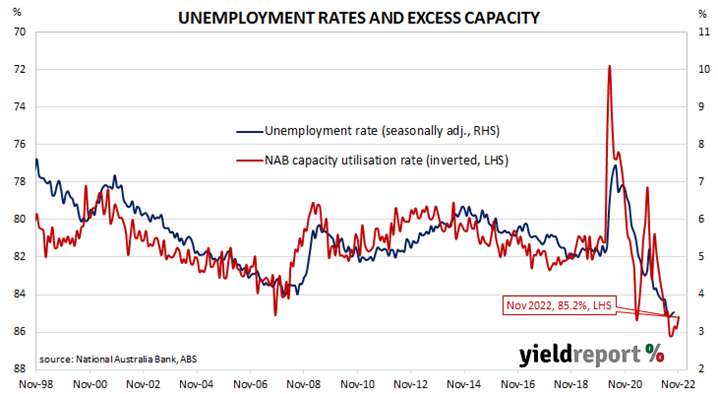Summary: Business conditions deteriorate in November; confidence also deteriorates, well below long-term average; confidence index below zero, first negative since December 2021; economy’s strength set to end in 2023; capacity utilisation rate declines but still elevated.
NAB’s business survey indicated Australian business conditions were robust in the first half of 2018, with a cyclical-peak reached in April of that year. Readings from NAB’s index then began to slip and forecasts of a slowdown in the domestic economy began to emerge in the first half of 2019 as the index trended lower. It hit a nadir in April 2020 as pandemic restrictions were introduced but then conditions improved markedly over the next twelve months. Subsequent readings were generally in a historically-normal range until the second half of 2022.
According to NAB’s latest monthly business survey of over 500 firms conducted over the last week of November, business conditions have deteriorated for a second consecutive month while managing to remain at an elevated level. NAB’s conditions index registered 20, down 2 points from October’s reading.
Business confidence also deteriorated. NAB’s confidence index fell from October’s reading of 0 to -4, a reading which is well below the long-term average. Typically, NAB’s confidence index leads the conditions index by one month, although some divergences have appeared from time to time.
“Business confidence turned negative in November, falling below zero for the first time since December 2021, while conditions remained elevated at +20 index points despite easing 2 points in the month,” said Westpac Senior Economist, Gareth Spence.
Commonwealth Government bond yields moved higher on the day. By the close of business, the 3-year ACGB yield had gained 5bps to 3.13%, the 10-year yield had inched up 1bp to 3.40% while the 20-year yield finished 2bps higher at 3.73%.
In the cash futures market, expectations regarding future rate rises firmed slightly. At the end of the day, contracts implied the cash rate would rise from the current rate of 3.06% to average 3.18% in February and then increase to an average of 3.295% in May. August 2023 contracts implied a 3.65% average cash rate while November 2023 contracts implied 3.64%.
“Overall, the survey highlights a growing concern that the economy’s strength over 2022 is set to come to an end as we enter 2023, and forward orders have softened…reflecting a more uncertain outlook,” Spence concluded.
NAB’s measure of national capacity utilisation remained at a historically-elevated level although it declined from 85.8% to 85.2%. All eight sectors of the economy were reported to be operating above their respective long-run averages.
Capacity utilisation is generally accepted as an indicator of future investment expenditure and it also has a strong inverse relationship with the unemployment rate.



